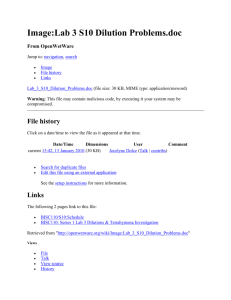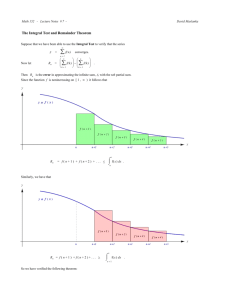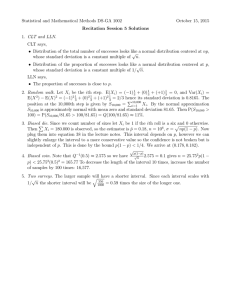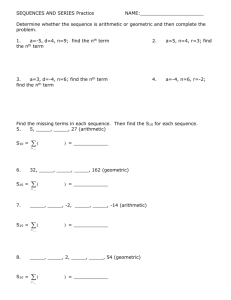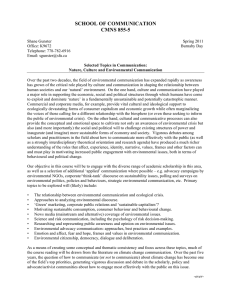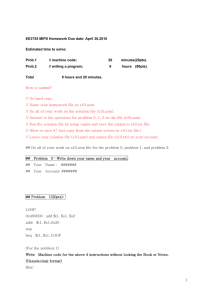A DEONTIC COUNTERPART OF LEWIS’ S1
advertisement
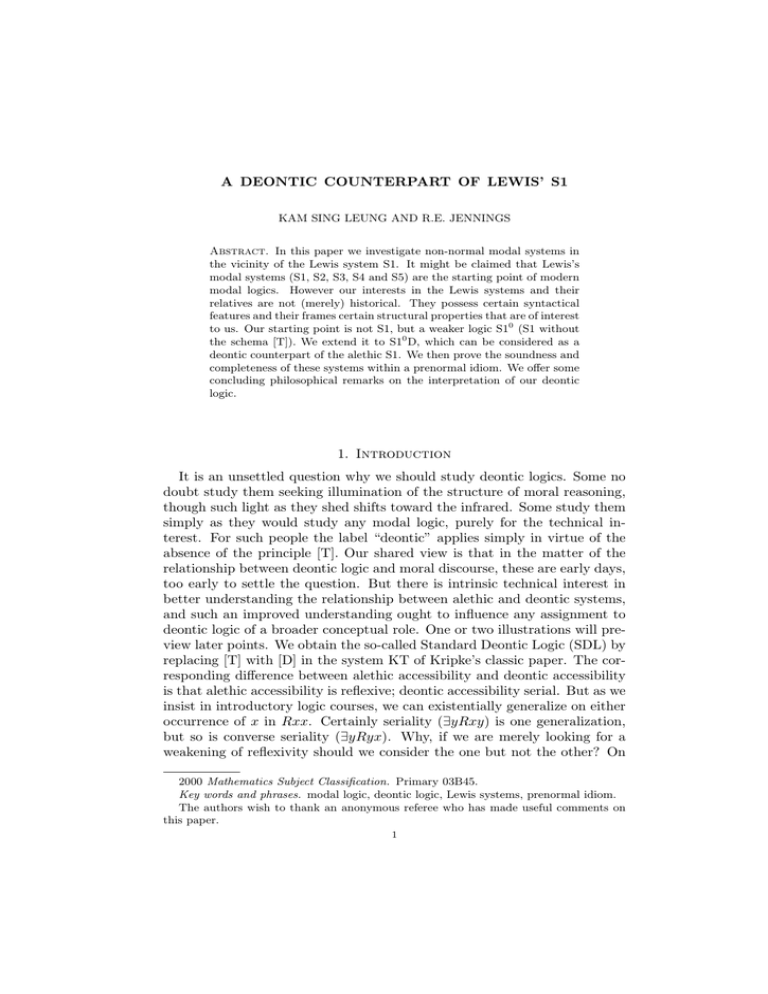
A DEONTIC COUNTERPART OF LEWIS’ S1
KAM SING LEUNG AND R.E. JENNINGS
Abstract. In this paper we investigate non-normal modal systems in
the vicinity of the Lewis system S1. It might be claimed that Lewis’s
modal systems (S1, S2, S3, S4 and S5) are the starting point of modern
modal logics. However our interests in the Lewis systems and their
relatives are not (merely) historical. They possess certain syntactical
features and their frames certain structural properties that are of interest
to us. Our starting point is not S1, but a weaker logic S10 (S1 without
the schema [T]). We extend it to S10 D, which can be considered as a
deontic counterpart of the alethic S1. We then prove the soundness and
completeness of these systems within a prenormal idiom. We offer some
concluding philosophical remarks on the interpretation of our deontic
logic.
1. Introduction
It is an unsettled question why we should study deontic logics. Some no
doubt study them seeking illumination of the structure of moral reasoning,
though such light as they shed shifts toward the infrared. Some study them
simply as they would study any modal logic, purely for the technical interest. For such people the label “deontic” applies simply in virtue of the
absence of the principle [T]. Our shared view is that in the matter of the
relationship between deontic logic and moral discourse, these are early days,
too early to settle the question. But there is intrinsic technical interest in
better understanding the relationship between alethic and deontic systems,
and such an improved understanding ought to influence any assignment to
deontic logic of a broader conceptual role. One or two illustrations will preview later points. We obtain the so-called Standard Deontic Logic (SDL) by
replacing [T] with [D] in the system KT of Kripke’s classic paper. The corresponding difference between alethic accessibility and deontic accessibility
is that alethic accessibility is reflexive; deontic accessibility serial. But as we
insist in introductory logic courses, we can existentially generalize on either
occurrence of x in Rxx. Certainly seriality (∃yRxy) is one generalization,
but so is converse seriality (∃yRyx). Why, if we are merely looking for a
weakening of reflexivity should we consider the one but not the other? On
2000 Mathematics Subject Classification. Primary 03B45.
Key words and phrases. modal logic, deontic logic, Lewis systems, prenormal idiom.
The authors wish to thank an anonymous referee who has made useful comments on
this paper.
1
2
KAM SING LEUNG AND R.E. JENNINGS
its deontic reading the former yields [D], p → ¬¬p, which seems to say
that there are no moral conflicts; the second yields the rule of denecessitation (` α =⇒ ` α), which seems to say that the only logically obligatory
acts are theorems.
A second illustration concerns the very starting point of modal logics.
The system K is nowadays regarded as the base Kripkean system since it is
the system corresponding to the class of all relational frames. But it also
corresponds post-facto to an interpretive intuition: that the set of necessities
constitutes a theory, that is, a deductively closed set. To that system, we add
either an alethic principle or a deontic one depending upon whether we seek
an alethic or a deontic system. But that intuition is a happy consequence
of a convenient semantic idiom, rather than a desideratum that compels the
idiom. An algebraically inspired intuition might have suggested to some
that
[Con] ¬⊥
[N]
>
`α→β
[RM]
` α → β
ought to form the base system. Such a starting point for alethic modal logic
would have the happy consequence that and ♦ have precisely the same
logic. So this would yield a genuinely modal system, rather than a system of
necessity. For systems specifically of necessity or specifically of possibility,
different extensions would be required. But this system is already deontic
in character, and, moreover, a system in which obligation and permissibility
have the same logic.
Now one could find grounds for rejecting all of the principles of either system, except perhaps for the consistency principle [Con]. One might reject
K because it permits no distinction between [Con] and [D]. One could reject
[RM] as too strong, and one could reject [N] on the grounds that all obligations ought to be shirkable. Of course this last intuition is not adequately
satisfied by the elimination of [N]. We would require a positive principle that
states as much, a principle such as
[Anti-N] ¬>.
The point of these remarks is to justify the study of deontic logics in the
region of S1. A first step toward doing so is to establish a base from which
to explore generalizations of these systems and enlargements of the class
of model-structures. If we needed an excuse for such explorations, they
need not be that the system itself has plausible deontic interpretations. By
such a standard, there would be no justification for studying SDL, all of
whose basic principles are deontically implausible. However S1 is a system
in which an obvious alternative to the standard weakening of reflexivity is
natural. And it is a system for which an intriguing re-interpretation of nonnormality presents itself, not perhaps for immediate deontic liquidity, but
for experimental modification.
A DEONTIC COUNTERPART OF LEWIS’ S1
3
This is the point at which to end our excuse-making. All such explorations
are experimental. It is the notion that the study of deontic logics has got
beyond the stage of primary research that is suspect, and probably illusory.
2. Lewis Systems and their Relatives
Lemmon in [6] provides alternative axiomatizations of the Lewis systems
S1-S4 with a propositional logic basis. Before introducing Lemmon’s axiomatizations, we list the axioms that we need in the following:
[X]
[K]
[K!]
[M]
[C]
[D]
[T]
(p → q) → ((q → r) → (p → r))
(p → q) → (p → q)
(p → q) → (p → q)
(p ∧ q) → (p ∧ q)
(p ∧ q) → (p ∧ q)
p → ♦p
p → p
The following rules of inference are also required:
[RN]
`α
` α
[RdN]
` α
`α
[RM]
[RNAx ]
α ∈ Axioms
` α
[RNPL ]
α ∈ PL
` α
`α→β
` α → β
[S RM]
`α≺β
` α ≺ β
[RE]
`α↔β
` α ↔ β
[S RE]
`α=β
` α = β
[REPL ]
α ↔ β ∈ PL
` α ↔ β
[Eq]
`α↔β
` γ ↔ γ[α/β]
[S Eq]
`α=β
` γ = γ[α/β]
[EqPL ]
α ↔ β ∈ PL
` γ ↔ γ[α/β]
[RRE]
` α ↔ β, ` γ
` γ[α/β]
[RRSE]
` α = β, ` γ
` γ[α/β]
[RRTE]
α ↔ β ∈ PL, ` γ
` γ[α/β]
[MP]
` α → β, ` α
`β
[S MP]
` α ≺ β, ` α
`β
Notes:
• α ≺ β abbreviates (α → β).
• α = β abbreviates (α ≺ β) ∧ (β ≺ α).
• γ[α/β] is the wff resulting from replacing some (possibly zero) occurrence of α in γ with an occurrence of β.
• “RN” stands for the rule of necessitation, “RdN” for the rule of
denecessitation, “RM” for the rule of monotonicity, “RE” for the rule
of extensionality, “Eq” for equivalents, “RRE” (“RRSE”, “RRTE”)
for the rule of replacement of (strict, tautologous) equivalents, “MP”
for modus ponens, the prefix “S” for strict (it means that the rule
is the strict version of the named rule), and the suffixes “Ax” and
4
KAM SING LEUNG AND R.E. JENNINGS
“PL” for axioms and propositional logic (it means that the named
rule is restricted to axioms or tautologies).
Definition 2.1. Lewis systems S1 to S5 are as follows: (Non-Lewis systems
S0.5, S0.9 and T are included for comparison.)
S0.5
S0.9
S1
S2
S3
S4
:
:
:
:
:
:
PL,
PL,
PL,
PL,
PL,
PL,
[RNPL ],
[K], [T]
[RNAx ], [S RE], [K], [T]
[RNAx ], [S Eq], [X], [T]
[RNAx ], [S RM], [K], [T]
[RNAx ],
[K!], [T]
[RN],
[K!], [T]
T : PL, [RN], [K], [T]
S4 : PL, [RN], [K], [T], [4]
S5 : PL, [RN], [K], [T], [5]
Here PL means the set of all tautologies together with the rules of modus
ponens ([MP]) and uniform substitution for propositional variables ([US]).
Note that when listed as part of a system, tautologies are considered as
axioms of the system in question.
In the following we adopt the Chellas and Segerberg axiomatization of
S10 in [1] with some modifications.1
Definition 2.2. The systems S10 , S10 D, and S10 T are as follows:
S10
: PL, [RNAx ], [RdN], [S Eq], [X]
S10 D
: PL, [RNAx ], [RdN], [S Eq], [X], [D]
0
S1 T (S1) : PL, [RNAx ],
[S Eq], [X], [T]
By “10 system”, we mean a system that includes PL and provides [RNAx ],
[RdN], [S Eq], and [X]. Thus S10 is the smallest 10 system. (Note that S10 T
is just S1.)
3. Prenormal Idiom
Cresswell in [2, 3] provides a semantic analysis for S1. The models he uses
combine the Kripkean style binary relational models with the neighbourhood
models introduced by Montague and Scott. In the next two sections, we
extend his method to analyze S10 and its extension S10 D. However we do this
within a “prenormal idiom” based on a recent recast and generalization of
Cresswell’s semantics for S1 by Chellas and Segerberg ([1]). (Note: Chellas
and Segerberg develop the semantics to study a class of logics which they
call “prenormal logics”; hence we call their semantics “prenormal idiom”
although the name is not used by them.)
1Chellas and Segerberg give two axiomatizations of S10 , both of which are somewhat
different from the one we provide here. For example, their first axiomatization, using the
symbols of this paper, is PL, [RNAx ], [S MP], [RRSE], and [X]. It can easily be shown that
it is equivalent to the axiomatization of S10 we adopt here. For the purpose of this paper,
taking [RdN] instead of [S MP] as primitive has the advantage of showing how S10 can be
obtained from S1 by replacing [T] with its weaker rule counterpart [RdN].
A DEONTIC COUNTERPART OF LEWIS’ S1
5
Definition 3.1. A prenormal frame F is an ordered quintuple hU, N, Q, R, Si
where:
(1) U (the universe of the frame) is a non-empty set of points.
(2) N (the set of normal points) and Q (the set of non-normal or queer
points) are disjoint subsets of U that exhaust it (i.e., N ∩ Q = ∅ and
N ∪ Q = U ).
(3) R is a binary relation in N × U .
(4) S : Q → ℘(℘(U )) is a neighbourhood function subject to the condition that for every x ∈ Q, U 6∈ S(x).
Definition 3.2. Let F = hU, N, Q, R, Si be a prenormal frame. A model
M on F is an ordered pair hF, V i where V : At → ℘(U ) is a function which
maps each atom (of the propositional modal language) to a set of points of
U.
Definition 3.3. The prenormal idiom P is the ordered triple hL, C, Ti where
L is the propositional modal language, C is the class of all prenormal frames,
and T (truth in the idiom) is defined recursively on the set of wffs in accordance with the following truth conditions for α (the truth conditions for
atoms and propositional connectives are as usual):
M
For x ∈ N : |=M
x α ⇐⇒ (∀y ∈ U, Rxy =⇒|=y α).
M
M
For x ∈ Q : |=x α ⇐⇒ kαk ∈ S(x).
(Note: kαkM is {x ∈ U | |=M
x α}, the truth set of α in M.)
In this paper, we are interested in a restricted sense of validity: a formula is valid (in our restricted sense) on a prenormal frame iff it is true
at every normal point in every model on that frame. Following Chellas
and Segerberg in [1], we call validity relativized to normal points “Lewisvalidity”. Formally,
Definition 3.4. Let F = hU, N, Q, R, Si be a prenormal frame. Then a wff
α is said to be Lewis-valid on F (F |=Lew α) iff for every model M on F and
x ∈ N , |=M
x α.
Definition 3.5. Let D be a class of prenormal frames. Then a wff α is said
to be Lewis-valid on D(D |=Lew α) iff for every F ∈ D, F |=Lew α.
The notions of soundness, completeness, and determination of a system
with respect to a class of prenormal frames can be defined in terms of Lewisvalidity. As in the case of validity, we label them “Lewis-soundness”, “Lewiscompleteness”, and “Lewis-determination”.
4. A Semantics for S10
In this section, we show that the system S10 is Lewis-determined with
respect to a certain class of prenormal frames (which we call “10 frames”).
Definition 4.1. A 10 frame is a prenormal frame F = hU, N, Q, R, Si which
satisfies the following conditions:
6
KAM SING LEUNG AND R.E. JENNINGS
(1) N 6= ∅.
(2) ∀x ∈ U, ∃y ∈ N : Ryx.
(3) ∀x ∈ Q, ∀a, b ⊆ U, a, b ∈ S(x) =⇒ a ∪ b 6= U.
Theorem 4.2. The system S10 is Lewis-sound with respect to the class C10
of all 10 frames.
Proof. Clearly all the tautologies and [X] are true at every normal point in
any model on any 10 frame. Thus they are Lewis-valid in C10 . For the next
part of the proof, observe that they are also true at every queer point in any
model on any 10 frame. The case for tautologies is obvious. For [X], note
that for any 10 model M = hU, N, Q, R, S, V i, kp → qkM ∪ kq → rkM = U .
Thus for any x ∈ Q, it is not the case that both kp → qkM ∈ S(x) and
kq → rkM ∈ S(x) (by condition (3) in Definition 4.1). Thus [X] is trivially
true at every queer point.
For [RNAx ], note that any axiom α (a tautology or [X]) is true at every
point, normal or queer, in any model on any 10 frame. Thus its necessitation α is true at every normal point in any such model. In other words,
C10 |=Lew α.
For [RdN], assume that C10 |=Lew α, i.e., α is true at every normal
point in any model on any 10 frame. Then C10 |=Lew α since every normal point in any such model has a normal predecessor (by condition (2) of
Definition 4.1).
For [S Eq], assume that C10 |=Lew α = β (and show that C10 |=Lew γ =
γ[α/β]). Let x be a point (normal or queer) in any model M on any 10
frame. From the assumption, (α ↔ β) is true at every normal point,
and, by condition (2) of Definition 4.1, x has a normal predecessor. Thus
|=M
x α ↔ β. Then the following hold:
|=M
x ¬α ↔ ¬β
|=M
x α ↔ β
|=M
x (α → δ) ↔ (β → δ)
|=M
x (δ → α) ↔ (δ → β).
Thus:
C10 |=Lew ¬α = ¬β
C10 |=Lew α = β
C10 |=Lew (α → δ) = (β → δ)
C10 |=Lew (δ → α) = (δ → β).
From the above we can conclude that C10 |=Lew γ = γ[α/β].
a
In proving the completeness of 10 systems, we adopt the Henkin style of
completeness proof. The strategy is as follows: for any 10 system L, we
define a prenormal frame and model called the L-canonical frame and Lcanonical model (the set of normal points of the frame and model is the
set of all the maximal L-consistent sets of wffs), and show that (A) a wff is
true at a point in the canonical model iff it is a member of that point (the
fundamental theorem for 10 systems), and (B) the canonical frame is in a
class C of prenormal frames. From the above results we can argue that any
non-L-theorem is Lewis-invalid in class C (since any such wff is absent from
some normal point of the L-canonical model), and so any wff Lewis-valid in
A DEONTIC COUNTERPART OF LEWIS’ S1
7
C is an L-theorem. To demonstrate (A) and (B), we initially derive several
theorems and rules of inference for a 10 system, and demonstrate several
general propositions about 10 canonical frames.
Lemma 4.3. Let L be a system including PL. Then the following hold :
(1)
(2)
(3)
(4)
In the presence of [RdN], if L has [S Eq], then it also has [RRSE].
In the presence of [RNPL ], if L has [RRSE], then it also has [RRTE].
In the presence of [RRTE], if L has [X], then it also has [K].
In the presence of [RNPL ], if L has [K], then it also has [M] and
[C].
Proof. We assume that in each case L has the rule(s) and/or schema stipulated.
For (1). To show that L has [RRSE], assume that ` α = β and ` γ.
By [S Eq], ` γ = γ[α/β], and so by PL, ` (γ → γ[α/β]). Then by [RdN],
` γ → γ[α/β]. Then by [MP], ` γ[α/β].
For (2). To show that L has [RRTE], assume that α ↔ β ∈ PL and ` γ.
Then by [RNPL ], ` α = β. Then by [RRSE], ` γ[α/β].
For (3). To show that L has [K], note that ` (p → q) → ((q → r) →
(p → r)). Then by [US], ` (> → p) → ((p → q) → (> → q)). But
the wffs (> → p) and p are tautologous equivalents, and so are (> → q) and
q. Thus by [RRTE], ` p → ((p → q) → q).
For (4). By PL and [RNPL ], ` (p∧q → p). Then by [K], ` (p∧q) → p.
Similarly, ` (p ∧ q) → q. Thus by PL, we have [M] (p ∧ q) → p ∧ q
as an L-theorem.
To obtain [C], note that by PL and [RNPL ], ` (p → (q → p ∧ q)). Then
by successive use of [K], ` p → (q → (p ∧ q)), i.e., the schema [C] is an
L-theorem.
a
Since any 10 system includes PL and provides the rules [RdN], [S Eq]
[RNAx ] (hence [RNPL ]) and the schema [X], we can help ourselves to all of
the rules and schemata mentioned in the above lemma when proving rules
and theorems for any such system.
Lemma 4.4. A 10 system has the following rules:
` α
` > ≺ α
`α
(3)
` > ≺ α
` α, ` ¬> ≺ α
(4)
` α
(1)
(2)
` α
` > ≺ α
Proof. For (1). Assume that ` α. Note that α ↔ (> → α) ∈ PL. Thus
by [RNPL ], ` α = (> → α). Then by [S Eq], ` α = (> → α), and
so ` (α → (> → α)). Then by [RdN], ` α → (> → α), and so
by assumption together with [MP], ` (> → α). But ` (> → >) (by
8
KAM SING LEUNG AND R.E. JENNINGS
applying [RNPL ] to the tautology > → >). Thus by [X], ` (> → α),
i.e., ` > ≺ α.
For (2). Assume that ` α. Then ` (> → α) (as we have shown
when proving (1)). But ` (α → >) (by applying [RNPL ] to the tautology
α → >). Thus ` > = α, and so by [S Eq], ` > = α, whence we conclude
that ` > ≺ α.
For (3). Assume that ` α, i.e., α has a proof. We show by induction on
the lines of the proof of α that ` > ≺ αk , for every line αk of the proof.
For α1 , it is an axiom. Thus by [RNAx ], ` α1 . Then by (1), ` > ≺ α1 .
For the induction step, the case of αk being an axiom is the same as α1 .
The other cases are αk being obtained from previous line(s) by an application
of one of the following rules: [RNAx ], [RdN], [S Eq], [MP]. In the following
we show each case in turn.
(a) If [RNAx ], αk is αi (i < k) and αi is an axiom. Then by [RNAx ],
` αi , and so by (2), ` > ≺ αi , i.e., ` > ≺ αk .
(b) If [RdN], there is a previous line αk . By I.H., ` > ≺ αk . Then
by [RdN], ` > → αk . Since ` > (by [RNPL ]), ` αk . Then by
(1), ` > ≺ αk .
(c) If [S Eq], αk is β = β[γ/δ] where there is a previous line γ = δ. Note
that ` (β ↔ β) (by applying [RNPL ] to the tautology β ↔ β).
Then by (2), ` > ≺ (β ↔ β), i.e., ` > ≺ (β = β). Then by
[RRSE], ` (> ≺ (β = β))[γ/δ], and so ` > ≺ (β = β[γ/δ]), i.e.,
` > ≺ αk .
(d) If [MP], there are two previous lines αi and αi → αk . From I.H.,
` > ≺ αi and ` > ≺ (αi → αk ). Then ` > ≺ αk . (Note that
(α ≺ β) ∧ (α ≺ (β → γ)) → (α ≺ γ) is provable from the tautology
(p → q) ∧ (p → (q → r)) → (p → r) by using [RNPL ], [K] and [C].)
For (4). Assume that ` α and ` ¬> ≺ α. From [X], ` (¬q → p) ∧
(p → q) → (¬q → q). Then by [RRTE], ` (¬p → q) ∧ (p → q) → q,
i.e., ` (¬p ≺ q) ∧ (p ≺ q) → q. Then by [US], ` (¬> ≺ α) ∧ (> ≺ α) →
α. Then by assumptions, (3) and [MP], ` α.
a
Lemma 4.5. A 10 system has the following theorem and rule:
(1) ♦(p ∧ q) → (♦p ∧ ♦q)
` ♦α → β
(2)
`α→β
Proof. For (1). p → p ∨ q is a tautology. Thus by [RNPL ] and [K], ` p →
(p ∨ q). Similarly, ` q → (p ∨ q). Then by PL, ` p ∨ q → (p ∨ q),
and so ` ♦¬(p ∨ q) → (♦¬p ∧ ♦¬q). Finally by [RRTE], ` ♦(¬p ∧ ¬q) →
(♦¬p ∧ ♦¬q).
For (2). Assume that ` ♦α → β. By (1), ` ♦(α ∧ ¬β) → (♦α ∧ ♦¬β).
Then by PL and [RRTE]: ` (¬♦α∨¬♦¬β) → ¬♦¬(α → β); ` (¬♦α∨β) →
(α → β); ` (♦α → β) → (α → β). Then by assumption and [MP],
` (α → β), and by [RdN], ` α → β.
a
A DEONTIC COUNTERPART OF LEWIS’ S1
9
Lemma 4.6. A 10 system has the following theorem:
(1) α ∧ (α → β) ≺ >
Proof. From [X] and [RNAx ], ` (¬α → α) ∧ (α → (α → β)) ≺ (¬α →
(α → β)). Then by [RRTE], ` α ∧ (α → β) ≺ >.
a
We are now in a position to prove the fundamental theorem for 10 systems
(after defining the canonical frames and models for such systems). However, to facilitate the presentation of the proofs of the fundamental theorem
and subsequent completeness theorems, we will, after defining the canonical frames and models for 10 systems, demonstrate two more lemmas about
their canonical frames.
Definition 4.7. Let L be a 10 system. Then the canonical frame for L is
the prenormal frame FL = hUL , NL , QL , RL , SL i where:
(1) x ∈ NL iff x is a maximal L-consistent set of wffs.
(2) x ∈ QL iff x is a maximal PL-consistent set of wffs satisfying both
of the following conditions:
(a) The set {¬α|α ∈
/ x} of wffs is L-consistent.
(b) > ∈
/ x.
(3) ∀x ∈ NL , ∀y ∈ UL , RL xy ⇐⇒ (x) ⊆ y.
(4) ∀x ∈ QL , ∀a ⊆ UL , a ∈ SL (x) ⇐⇒ ∃α : a = |α|L & α ∈ x.
(Note: (x) is {α|α ∈ x}, and |α|L is {x ∈ UL |α ∈ x}.)
We note that FL as defined above is indeed a prenormal frame since NL
and QL are disjoint (>, being a theorem of L, is in every normal point but
it is not in any queer point.)
Definition 4.8. Let L be a 10 system. Then the canonical model for L is
the prenormal model ML = hFL , VL i where:
(1) FL = hUL , NL , QL , RL , SL i is the L-canonical frame.
(2) For every p ∈ At, VL (p) = |p|L .
Lemma 4.9. Let FL = hUL , NL , QL , RL , SL i be the canonical frame for a 10
system L. Then for every x ∈ NL and wff α,
α ∈
/ x =⇒ ∃y ∈ UL : RL xy & α ∈
/ y.
Proof. Let x be a normal point. Assume that α ∈
/ x. It is sufficient to
show that the set Σ = (x) ∪ {¬α} has an extension in NL or QL . For
reductio assume neither. That is, assume that (1) Σ is not L-consistent and
(2) if y is a maximal PL-consistent extension of Σ, then y contains >. (For
the second point, note that if y is a maximal PL-consistent extension of Σ,
then the set {¬α|α 6∈ y} is already L-consistent since it is a subset of x.)
From (1) and (2) above, we can infer the following:
∃β1 , . . . , βn ∈ (x) : {β1 , . . . , βn , ¬α} `L ⊥
`L β1 ∧ · · · ∧ βn → α.
∃γ1 , . . . , γm ∈ (x) : {γ1 , . . . , γm , ¬α, ¬>} `PL ⊥
`PL ¬> → ((γ1 ∧ · · · ∧ γm ) → α).
10
KAM SING LEUNG AND R.E. JENNINGS
Let δ = β1 ∧· · ·∧βn ∧γ1 , . . . , γm . Then from the above, we have (i) `L δ → α
and (ii) `PL ¬> → (δ → α). From (ii) and by [RNPL ], `L ¬> ≺ (δ → α).
Then by (i) and Lemma 4.4(4), `L (δ → α). Then by [K], `L δ → α and
so δ → α ∈ x (note that every L-theorem is in x). However δ ∈ x since
β1 , . . . , βn , γ1 , . . . , γm ∈ x and L provides [C]. Thus by the deductive
closure of maximal L-consistent sets, α ∈ x. But this is contrary to the
initial assumption that α ∈
/ x. Thus by reductio, (x) ∪ {¬α} has an
extension in NL or QL .
a
Lemma 4.10. Let L be a 10 system. Then for any wffs α and β,
|α|L = |β|L =⇒ `L α = β.
Proof. Let α and β be arbitrary wffs. Assume that |α|L = |β|L , i.e., for any
x ∈ UL , α ∈ x iff β ∈ x. In other words, α ↔ β ∈ x, for every x ∈ UL .
Assume, for reductio, that 6`L α = β. Then there exists an x0 ∈ NL such
that (α ↔ β) ∈
/ x0 . Then by Lemma 4.9, there exists a y ∈ UL such that
0
RL x y and α ↔ β ∈
/ y. But this is contrary to what can be inferred from
the initial assumption. Thus, by reductio, `L α = β.
a
Theorem 4.11 (The Fundamental Theorem for 10 Systems).
Let ML = hUL , NL , QL , RL , SL , VL i be the canonical model for a 10 system
L. Then, for every x ∈ UL and wff α,
L
|=M
α ⇐⇒ α ∈ x.
x
Proof. The proof is by induction on the structure of α. The only interesting
L α ⇐⇒ α ∈ x
case is the modal one. Assume that for every x ∈ UL , |=M
x
L α ⇐⇒ α ∈ x. We show
(I.H.), and show that for every x ∈ UL , |=M
x
only the difficult direction, viz., =⇒. Either x ∈ NL or x ∈ QL .
For x ∈ NL . Assume, for contraposition, that α ∈
/ x. Then by Lemma
L α (I.H.).
4.9, there exists a y ∈ UL such that RL xy and α ∈
/ y, i.e., 6|=M
y
M
L
Thus 6|=x α.
L α. Then kαkML ∈ S , i.e., |α|
For x ∈ QL . Assume that |=M
L
L ∈ SL
x
(by I.H.). Then for some wff β, |α|L = |β|L & β ∈ x. By Lemma 4.10, we
can infer that `L α = β, and by [S Eq], `L α = β. Then the wff α = β
is in every normal point. Moreover it is evident that every queer point (say
x0 ) has a normal predecessor (since the set {¬α|α ∈
/ x0 } is L-consistent
0
and so has an extension y in NL such that (y) ⊆ x ). Thus α ↔ β is
in every queer point. Thus α is in x since β is.
a
Theorem 4.12. The canonical frame for the system S10 is in the class C10
of frames.
Proof. Let FS10 = hUS10 , NS10 , QS10 , RS10 , SS10 i be the canonical frame for
S10 . We show that it is a 10 frame, that is, it satisfies the conditions stipulated in Definition 4.1. Clearly NS10 is non-empty since S10 is consistent.
The more interesting conditions are the requirements that (1) every point
in US10 has a normal predecessor and that (2) no two neighbourhoods of a
queer point “cover” the universe.
A DEONTIC COUNTERPART OF LEWIS’ S1
11
For (1). If x ∈ QS10 , it is evident that it has a normal predecessor since
the set {¬α|α ∈
/ x} is S10 -consistent (as we have already argued when
proving Theorem 4.11). It remains to show that the same holds for every
normal point. Thus let x ∈ NS10 be arbitrary. Assume, for reductio, that
the set {¬α|α ∈
/ x} is not S10 -consistent. Then, for some β1 , . . . , βn ∈
/ x:
{¬β1 , . . . , ¬βn } `S10 ⊥
`S10 (¬β1 ∧ · · · ∧ ¬βn−1 ) → βn
`S10 (♦¬β1 ∧ · · · ∧ ♦¬βn−1 ) → βn
`S10 ♦(¬β1 ∧ · · · ∧ ¬βn−1 ) → βn
by Lemma 4.5(1)
`S10 (¬β1 ∧ · · · ∧ ¬βn−1 ) → βn
by Lemma 4.5(2).
Then (¬β1 ∧ · · · ∧ ¬βn−1 ) → βn ∈ x. But ¬β1 , . . . , ¬βn−1 ∈ x. Then βn ∈ x,
which is absurd since βn ∈
/ x. Thus, by reductio, the set {¬α|α ∈
/ x} is
S10 -consistent, whence we can argue that x has a normal predecessor.
For (2). Let x be a queer point, a and b subsets of US10 . Assume that
a, b ∈ SS10 (x). Further assume for reductio that a∪b = US10 . Then for some
wffs α, β ∈ x, a = |α|S10 and b = |β|S10 . It is evident that |α → β|S10 ⊆
|β|S10 (since |α|S10 ∪ |β|S10 = US10 ), and so |α → β|S10 = |β|S10 . Then:
`S10 (α → β) = β
`S10 (α → β) = β
`S10 β ≺ (α → β).
by Lemma 4.10
by [S Eq]
Then β → (α → β) ∈ x (since every queer point has a normal predecessor). Then (α → β) ∈ x (since β ∈ x). But α ∧ (α → β) → > ∈ x
(by Lemma 4.6 and x having a normal predecessor). Since α, (α → β) ∈
x, we have > ∈ x, which is absurd. Thus by reductio a ∪ b 6= US10 .
a
Theorem 4.13. The system S10 is Lewis-complete with respect to the class
C10 of frames.
Proof. The Lewis-completeness of the system S10 with respect to the class
C10 of frames follows directly from the Fundamental Theorem for S10 systems and the theorem that the canonical frame for S10 is in the class C10 of
frames (Theorems 4.11 and 4.12 respectively).
a
Theorem 4.14. The system S10 is Lewis-determined by the class C10 of
frames.
Proof. Since S10 is both Lewis-sound and Lewis-complete with respect to
the class C10 of frames, it is Lewis-determined by the class C10 of frames. a
5. A Semantics for S10 D
Definition 5.1. A 10 D frame is a 10 frame whose relational component R
satisfies the condition of seriality:
∀x ∈ N, ∃y ∈ U : Rxy.
Theorem 5.2. The system S10 D is Lewis-sound with respect to the class
C10 D of frames.
12
KAM SING LEUNG AND R.E. JENNINGS
Proof. It suffices to note that [D] is true at every point, normal or queer, in
any model on any 10 D frame.
a
Theorem 5.3. The canonical frame for the system S10 D is in the class
C10 D of frames.
Proof. Let FS10 D = hUS10 D , NS10 D , QS10 D , RS10 D , SS10 D i be the canonical
frame for S10 D. It suffices to show that RS10 D is serial. Let x ∈ NS10 D
be arbitrary. We show that the set (x) of wffs has an extension either
in NS10 D or QS10 D . For reductio, assume neither. That is to say, assume
that (1) (x) is not S10 D-consistent and (2) If y is a maximal PL-consistent
extension of (x), then it contains >. (Note that the set {¬α|α ∈
/ y} is
already S10 D-consistent since it is included in x.) From the above, we can
infer the following:
∃α1 , . . . , αn ∈ (x) : {α1 , . . . , αn } `S10 D ⊥
`S10 D α1 ∧ · · · ∧ αn−1 → ¬αn .
∃β1 , . . . , βm ∈ (x) : {β1 , . . . , βm , ¬>} `PL ⊥
{β1 , . . . , βm , ¬>, αn } `PL ⊥
`PL ¬> → ((β1 ∧ · · · ∧ βm ) → ¬αn ).
Let γ = α1 ∧ · · · ∧ αn−1 ∧ β1 ∧ · · · ∧ βm . Then from the above, we
have (i) `S10 D γ → ¬αn and (ii) `PL ¬> → (γ → ¬αn ). From (ii) and
by [RNPL ], `S10 D ¬> ≺ (γ → ¬αn ). Then by (i) and Lemma 4.4(4),
`S10 D (γ → ¬αn ). Then by [K], `S10 D γ → ¬αn . But every S10 Dtheorem is in x. Thus γ → ¬αn ∈ x. However γ ∈ x. (Note that
α1 , . . . , αn−1 , β1 , . . . , βm ∈ x, and so is [C].) Thus by the deductive
closure of maximal S10 D-consistent sets, ¬αn is in x. But this is absurd,
since αn ∈ (x), i.e., αn ∈ x and so ¬¬αn ∈ x (for [D] is a theorem of
S10 D and it is in x). Thus, by reductio, (x) has an extension in NS10 D or
QS10 D , whence we can conclude that x has a successor in US10 D .
a
Theorem 5.4. The system S10 D is Lewis-complete with respect to the class
C10 D of frames.
Proof. The Lewis-completeness of the system S10 D with respect to the class
C10 D of frames follows directly from the Fundamental Theorem for S10 system and the theorem that the canonical frame for S10 D is in the class C10 D
of frames. (Theorems 4.11 and 5.3 respectively).
a
Theorem 5.5. The system S10 D is Lewis-determined by the class C10 D of
frames.
Proof. Since S10 D is both Lewis-sound and Lewis-complete with respect
to the class C10 D of frames, it is Lewis-determined by the class C10 D of
frames.
a
6. Philosophical Remarks: From Alethic to Deontic Systems
If we were to drop the condition that R be reflexive, this
would be equivalent to abandoning the modal axiom A ⊃
A DEONTIC COUNTERPART OF LEWIS’ S1
13
A. In this way we could obtain systems of the type required
for deontic logic.
Thus Kripke at the conclusion of his seminal paper [5]. If we interpret α
as “It is a necessary truth that α”, then the principle [T] p → p and its
substitutional instances would be unavoidable. We may call systems that
have the principle [T] alethic systems. However as Kripke suggests in the
passage quoted above, [T] would be inappropriate for some other readings
of the modal operator , for example, if we interpret it as “It is obligatory
that . . . ” (deontic logic) or “An agent believes that . . . ” (doxastic logic).
For such readings, [T] had better be dropped or replaced by some weaker
principle such as [D] p → ♦p, though other weaker principles might do as
well or better. We may call such systems “T-less” systems (or we can adopt
the name “deontic logics”, while bearing in mind that the term has a stricter
meaning, viz., logics of obligation.) In this paper, we have followed a similar
path in choosing the systems S10 and S10 D for analysis. For comparison,
we list in the following three trios of logics, including the normal system K,
the regular system R, and their deontic and alethic extensions:
K
KD
KT
R
RD
RT
S10 S10 D S10 T (or S1)
(Note: The system K can be axiomatized by PL, [RN], and [K], and the
system R by PL, [RM], and [C]. The systems RD and RT are equivalent to
Lemmon’s D2 and E2 in [6].)
Before we comment on the interpretation of the deontic systems KD,
RD, and S10 D, we note a formal similarity in the above trios of systems.
Syntactically [D] is weaker than [T] (in the sense that [D] is derivable from
[T] but not the reverse in the absence of further axioms). This relation
between [D] and [T] is reflected by a similar relation between the classes
of frames to which the two principles correspond in the binary relational
idiom: [D] corresponds to seriality, which is weaker than reflexivity to which
[T] corresponds. However, the last trio brings out another point of interest:
the systems S10 , S10 D, and S10 T have the rule of denecessitation [RdN]
` α =⇒ ` α, which can be considered as another weak principle with which
one could replace [T] in moving from alethic systems to a T-less system.
Whether [RdN] could be given a plausible deontic reading (or some other
reading) is another matter. At least it is formally interesting to note that
the rule corresponds to converse seriality (every point has a predecessor),
the converse of seriality (every point has a successor).2 Both versions of
seriality are weaker than reflexivity, a relation echoing the derivability of
[RdN] and [D] from [T] in a formal system.
2The idea of rule correspondence (or defining a class of frames by a rule of inference)
is based on Kapron’s notion of modal sequent-axiomatic classes of frames in [4]. That the
rule of denecessitation [RdN] corresponds to converse seriality has first been noticed by
Peter Schotch in communication with Jennings.
14
KAM SING LEUNG AND R.E. JENNINGS
We do not give a detailed interpretation of the systems KD, RD and S10 D
here, but rather comment on a few points on their suitableness as a minimal
deontic logic (the smallest logic that would preserve our intuitions about
obligation). One of the (many) objections to the normal system KD as a
deontic logic is its use of the rule of necessitation [RN] ` α =⇒ ` α. What
the rule effectively says (in deontic terms) is that it is a logical law that any
law of logic is obligatory. But this seems to be contrary to our intuition
that logic by itself cannot give rise to obligations, and that only obligations
can give rise to obligations. It is because of this objection that we consider
non-normal logics RD and S10 D rather than the normal KD as plausible
candidates for the minimal deontic logic. Neither RD nor S10 D provides
the rule [RN] (although the latter system has [RNAx ], which is a weakened
version of [RN]). Semantically, they avoid the rule [RN] by the presence of
queer worlds at which there are no obligations whatsoever (in non-normal
frames) or no tautologous obligations (in prenormal frames). Whether this
is a satisfactory way to drop the rule [RN] is controversial, for it may be
objected that there are still logical obligations or tautologous obligations
at normal worlds. However we will pursue this point no further here, for
there is another objection to proposing RD and S10 D as candidates for the
minimal deontic logic.
An objection to RD and S10 D (and also KD) as being the minimal deontic
logic is related to their commitment to non-conflicting obligations (in virtue
of [D]). Whether there are genuinely conflicting obligations or not will not
be adjudicated here. However if our project is to find the minimal deontic
logic, the smallest logic that would preserve our intuitions about obligation,
then RD and S10 D do not qualify as the minimal deontic logic (at least not
without controversy). If so, we may ask whether [D] could be replaced by a
weaker and less controversial principle such as [Con] ¬⊥ (which is a weak
version of the Kantian principle that ought implies can). Unfortunately the
answer is no, for given the bases R and S10 of these systems, any extension
of these bases that has [Con] also provides [D]. Schotch and Jennings point
out in [7] that the minimal deontic logic should preserve important deontic
distinctions such as [D] and [Con]. If this is correct, then the systems formed
by adding [Con] to R or S10 would not be the minimal deontic logic we are
looking for. What that logic is must remain an open question.
References
[1] Brian F. Chellas and Krister Segerberg. Modal logics in the vicinity of S1. Notre Dame
Journal of Formal Logic, 37:1–24, 1996.
[2] M. J. Cresswell. The completeness of S1 and some related systems. Notre Dame Journal
of Formal Logic, 13:485–496, 1972.
[3] M. J. Cresswell. S1 is not so simple. In Walter Sinnott-Armstrong, Diana Raffman,
and Nicholas Asher, editors, Modality, Morality, and Belief: Essays in Honor of Ruth
Barcan Marcus, pages 29–40. Cambridge University Press, Cambridge, 1995.
[4] Bruce M. Kapron. Modal sequents and definability. Journal of Symbolic Logic,
52(3):756–762, 1987.
A DEONTIC COUNTERPART OF LEWIS’ S1
15
[5] Saul A. Kripke. Semantical analysis of modal logic I, non-normal propositional calculi.
Zeitschrift für mathematische Logik und Grundlagen der Mathematik, 9:67–96, 1963.
[6] E. J. Lemmon. New foundations for Lewis modal systems. Journal of Symbolic Logic,
22:176–186, 1957.
[7] P. K. Schotch and R. E. Jennings. Non-kripkean deontic logic. In R. Hilpinen, editor,
New Studies in Deontic Logic, pages 149–162. D. Reidel Publishing Company, 1981.
Department of Philosophy, Simon Fraser University, Burnaby, British Columbia,
Canada V5A 1S6
E-mail address: kleungd@sfu.ca
URL: http://www.sfu.ca/llep
Department of Philosophy, Simon Fraser University, Burnaby, British Columbia,
Canada V5A 1S6
E-mail address: jennings@sfu.ca
URL: http://www.sfu.ca/llep
